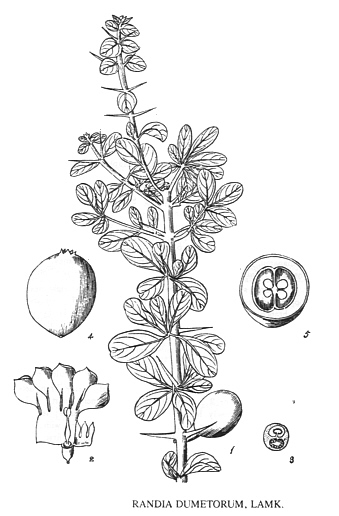

Zitierweise / cite as:
Carakasaṃhitā: Ausgewählte Texte aus der Carakasaṃhitā / übersetzt und erläutert von Alois Payer <1944 - >. -- Anhang A: Pflanzenbeschreibungen. -- Randia dumetorum (Retz.) Poir. -- Fassung vom 2007-05-10. -- URL: http://www.payer.de/ayurveda/pflanzen/randia_dumetorum.htm
Erstmals publiziert: 2007-03-19
Überarbeitungen: 2007-05-10 [Ergänzungen]
Anlass: Lehrveranstaltung SS 2007
©opyright: Dieser Text steht der Allgemeinheit zur Verfügung. Eine Verwertung in Publikationen, die über übliche Zitate hinausgeht, bedarf der ausdrücklichen Genehmigung des Verfassers
Dieser Text ist Teil der Abteilung Sanskrit von Tüpfli's Global Village Library
WARNUNG: dies ist der Versuch einer
Übersetzung und Interpretation eines altindischen Textes. Es ist keine
medizinische Anleitung. Vor dem Gebrauch aller hier genannten Heilmittel wird
darum ausdrücklich gewarnt. Nur ein erfahrener, gut ausgebildeter ayurvedischer
Arzt kann Verschreibungen und Behandlungen machen!
Falls Sie die diakritischen Zeichen nicht dargestellt bekommen, installieren Sie eine Schrift mit Diakritika wie z.B. Tahoma.
Verwendete und zitierte Werke siehe: http://www.payer.de/ayurveda/caraka0001.htm

Abb.: Randia dumetorum (Retz.) Poir
[Bildquelle: Kirtikar-Basu, ©1918]
Drury:
"Randia dumetorum (Lam.) N. 0. Cinchonaceae. Marukarung, Tam. Maugha, Tel. Myn, Hind.
Description.—Shrub, 6-10 feet, armed; spines opposite; leaves almost sessile, oval, cuneate at the base, when young, slightly pubescent; flowers axillary, solitary, terminal on the young shoots, on short pedicels ; calyx campanulate, 5-parted; lobes oblong ; corolla hirsute on the outside ; tube with a ring of dense hairs inside near the base; fruit usually globose, sometimes oblong, crowned with the limb of the calyx, 2-celled, many-seeded; flowers white. Fl. April.— W. & A. Prod. i. 396.— Wight Icon. t. 580.—Gardenia dumetorum, Retz. —Roxb. Cor. ii. t. 136.——Coromandel. Mahableshwar.
Medical Uses.—The fruit is used as an emetic. The bark of the root in infusion is used in the southern provinces as a nauseating medicine.—Roxb. The fruit is about the size of a crab-apple. It has a peculiar sweetish sickly smell: it is very commonly used as an emetic by the poorer classes in Mysore, and is said to be safe and speedy in its action. The dose is one ripe fruit, well bruised, which may be repeated if necessary.—Dr Bidie in Pharm. of India.) It is also used externally as an anodyne in rheumatism.—Stewart's Punj. Plants.
Economic Uses.—According to Dr Wight, the habit of this plant is extremely variable, as it grows in a poor or rich soil. The size of the fruit varies from that of a small cherry to as 'large as a walnut. The shrub is employed for fences in the places of its natural growth. The fruit bruised and thrown into ponds where fish are, they are soon intoxicated and seen floating. Fishermen frequently adopt this plan to catch fish; nor are the latter less wholesome to eat afterwards. —Roxb."
[Quelle: Drury, Heber <1819 - 1872>: The useful plants of India : with notices of their chief value in commerce, medicine, and the arts. -- 2d ed. with additions and corrections. London : Allen, 1873. -- xvi, 512 p. ; 22 cm. -- s.v.]
Dutt:
"RANDIA DUMETORUM, Linn. Sans. Madana.
Vern. Mayin, Hind.The Randia dumetorum is a small thorny tree common in waste places. The fruit when ripe, looks like a small apple, and has a peculiar sweetish, sickly smell. It is described by Sanskrit writers, as the best or safest of emetics. In fact the ancient Hindus depended chiefly upon this drug for causing emesis. One ripe fruit is generally administered for this purpose. It is also used in combination with other medicines, as for example in the following prescription.
Pancha kashāya. Take of Justicia Adhatoda (vāsaka), Acorus Calamus (vachā), nim bark, leaves of Trichosanthes dioica (paṭola), and bark of Aglaia Roxburghiana (priyangu), equal parts, half a seer in all, water eight seers ; boil them together till reduced to one fourth. This decoction is given with the addition of the pulp of Randia dumetorum for causing emesis."
[Quelle: Dutt, Uday Chand: The materia medica of the Hindus / Uday Chand Dutt. With a glossary of Indian plants by George King. -- 2. ed. with additions and alterations / by Binod Lall Sen & Ashutosh Sen. -- Calcutta, 1900. - XVIII, 356 S. -- S. 177f.]